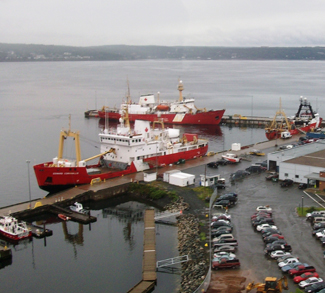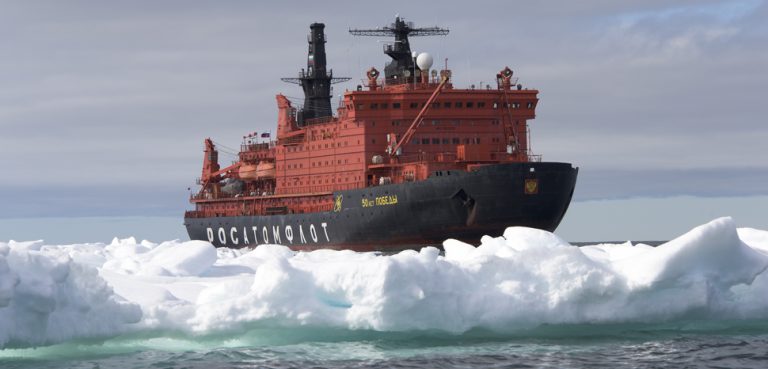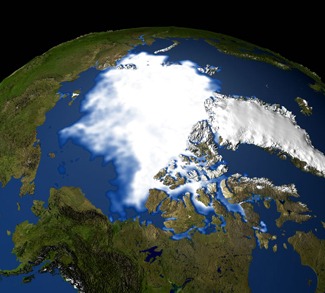While some policymakers insist on debating the validity of climate change, Arctic sea ice continues to melt. Some scientists predict that the region will be free of summer ice in as few as 30 years. Without question, the effects of environmental change have led to increased activity in the region, ushering in new possibilities in Arctic shipping lanes and resource development.
With 162,000 kilometers of Arctic coastline, it is undeniable that the increased global interest in the Arctic region is a pivotal concern to Canada’s strategic interests.
The Harper government has branded itself as a resolute defender of Canada’s Arctic sovereignty. But prime ministerial photo-ops and patriotic victories of recovered wrecks will not be sufficient to protect those interests, and one might argue that the reality of the sovereignty situation does not measure up to the government’s tone of rhetoric.
In 2009 the Canadian government released Canada’s Northern Strategy, a document outlining four priority areas to guide the country’s Arctic policy: exercising sovereignty, promoting social and economic development, protecting the environment, and improving and devolving governance.
The following year, the Conservative government further detailed those pillars in their Statement on Canada’s Foreign Arctic Policy. Exercising sovereignty over the Arctic was established as the government’s number one priority and it was declared that “in pursuing each pillar, Canada was committed to exercising the full extent of its sovereignty, sovereign rights, and jurisdiction in the region.”
Traditional notions of sovereignty rest on a state’s ability to govern itself free from outside interference. Arctic sovereignty also encompasses Canada being able to effectively monitor and enforce authority over its Northern land, sea, and air.
To that end, the federal government has made a number of steps in exercising sovereignty in the Arctic.
In September, Canadian fighter jets intercepted two Russian jets just 75 kilometers off Canada’s Arctic coast, just one day after Ukrainian President Poroshenko stood in Parliament to thank Canada for its support as his country battled separatist rebels.
Canadian forces take part in annual exercises in the Arctic and also participate in NORAD’s northern operations. The Department of National Defence upgraded RADARSAT II to engage in Arctic surveillance, and the Canadian Space Agency intends to launch a Polar Communication and Weather mission in the years to come. The federal government also recently opened an army training center in Resolute Bay, Nunavut.
But the sum of these efforts pales in comparison to the well-documented, massive military build-up that Russia has undertaken in the Arctic, which includes permanently stationing troops in the region, modernizing facilities from the Soviet-era, and building a vast number of new defense facilities.
Part of the disparity in the military footprints of these two Arctic neighbors can certainly be attributed to the relative size of their standing armies and defense budgets. It would also be unfair not to acknowledge that the Harper government has accomplished more in the region than previous administrations. But when the Conservatives use the Arctic as a key feature of their political brand and the government’s foreign policy documents speaks of “putting the full resources of the government of Canada behind the exercise of sovereignty, sovereign rights, and jurisdiction in the Arctic,” one has to suspect that Ottawa is putting rhetoric ahead of reality.
For example, when the Harper government announced the training centre in Resolute Bay, the original plan called for a long paved runway, hangers, and a fuel storage facility. But the finished product is merely a small dormitory that is now being used to house scientists more than any military personnel.
Canada’s Icebreaker Woes
Canada is sorely lacking in both quantity and quality in terms of its icebreaker fleet. These ships are needed to patrol coastlines, undertake research, and carry out search-and-rescue operations, all of which can be read as functions of asserting sovereignty.
Canada’s fleet currently consists of two heavy icebreakers, four medium icebreakers, nine multi-purpose vessels, and two hovercrafts.
The most powerful vessel, the Louis S. St-Laurent, has been in active service since 1969.
The ship was slated to be decommissioned in 2017 when it was to be replaced by the new John G. Diefenbaker, which the government announced plans for in their 2008 federal budget. However, now that the Diefenbaker has been delayed until 2021-22 the aging St-Laurent will remain in service until then.
In comparison, Russia has 38 vessels, more than twice the combined number of the rest of the Arctic nations, including six nuclear-powered ships. The Russians are currently building a massive seventh vessel which is fourteen meters longer than any other icebreaker in the world, and will be capable of cracking through up to three meters of ice.
While this country’s history of underfunding Canada’s Coast Guard dates back well before the current administration, the Harper government’s willingness to put political subterfuge ahead of sound, transparent policy is fairly evident in the procurement of new vessels for the Arctic theater.
When the Conservatives first came to power in January 2006, they campaigned on a promise to budget $5.3 billion over five years to ensure Arctic sovereignty. The central tenet of this commitment would be, amongst other things, the purchase of three heavy icebreakers. By 2007 however, the promise of those three vessels was replaced by six to eight lighter Arctic Patrol Ships that lacked icebreaking capabilities.
Construction on those vessels had still not begun when the federal government announced a new National Ship Procurement Strategy in 2012. That strategy affirmed their plans to build between six and eight patrol ships within the next quarter-century. But the independent Parliamentary Budget Officer (PBO) released a report last week noting the unlikelihood of being able to afford that many vessels on the current procurement budget of $3.1 billion, and instead suggested that a maximum of four patrol ships is a more realistic expectation for that figure.
Like much of the analysis that has emanated from that office in recent years, the report was met with derision by the Conservatives. The federal government accused the PBO of using erroneous data, to which the PBO replied that the Conservatives had refused to provide them with all the information that they needed for their report.
Harper Setting His Sights on the North Pole
Another area in which Canada is seeking to exercise sovereignty relates to gaining international recognition to the full extent of its ‘extended continental shelf.’
The extended continental shelf is the area beyond an Arctic country’s ‘‘exclusive economic zone’ (EEZ), which stretches 200 nautical miles from coastal baselines. The United Nations Convention on the Law of the Sea (UNCLOS) prescribes that coastal states have sovereign rights to the resources within their EEZ, but when a state’s continental shelf can be shown to extend beyond the EEZ, it also enjoys sovereign rights to explore and exploit the resources of the seabed and subsoil. Given the vast resources that are said to be in the Arctic seabed, the economic impact of precisely defining Canada’s continental shelf is huge.
In December 2013, Canada sent a partial submission to the UN Commission on the Limits of the Continental Shelf. But just days after making the submission, which was ten years in the making and asserted that the Canadian continental shelf covers 1.2 million square kilometers of ocean, the Foreign Affairs Minister announced that Canada would widen its claim to include the North Pole despite lacking the scientific evidence to support it.
The announcement left scientists scrambling to conduct more research and forced officials to upgrade the St-Laurent with $7 million worth of state-of-the-art sonar technology to carry out further testing.
The Economist speculated that the move amounted to chicanery on the part of Prime Minister Harper, who recognized that Canada’s claim will not be reviewed by the UN Commission until well after the next election, meaning that there was no domestic political downside to claiming the North Pole.
This reading of the situation gained some credibility when the Foreign Affairs Minister would not dispute published reports that Harper interceded at the last minute to insist that the North Pole would be included in Canada’s claim.
That narrative is largely speculative, but if accurate, it does nothing to support Ottawa’s line of the sanctity of Arctic sovereignty. Instead, by interfering with the scientific process and allowing domestic politics to override the international legal procedure, the Harper government has again supplanted sound Arctic policy with blustery rhetoric.
**Nov 20. A correction was made concerning the size of Canada’s coast guard fleet.




